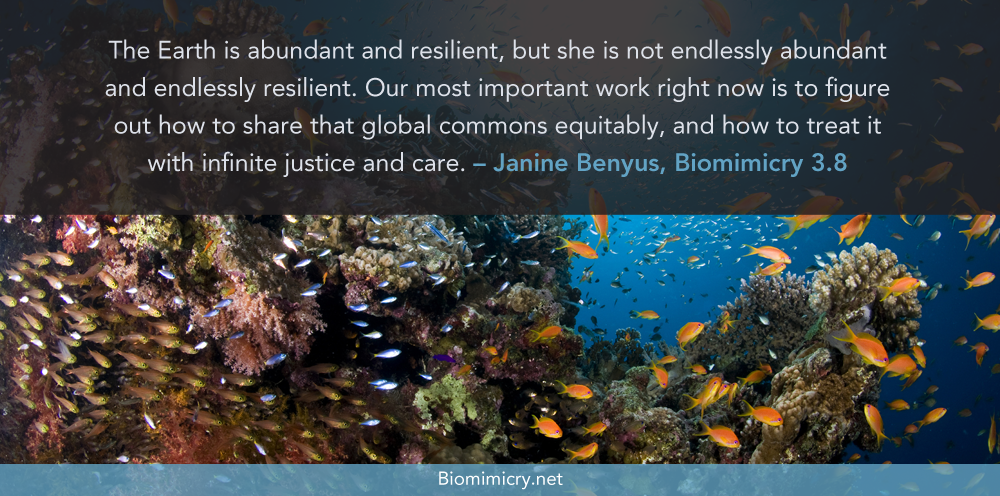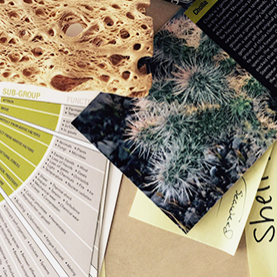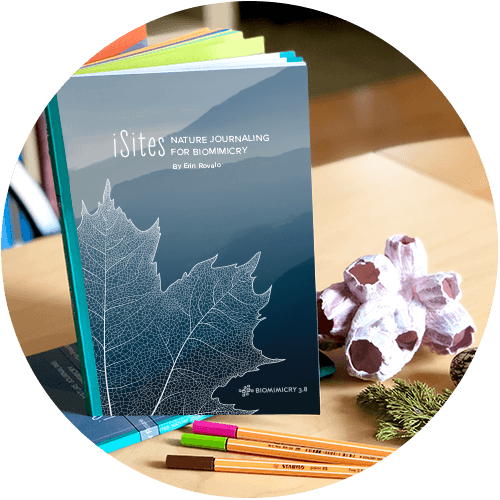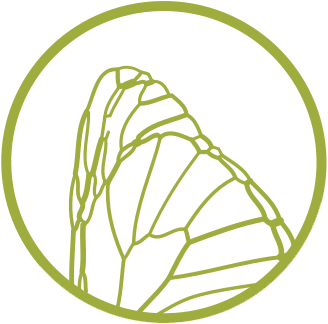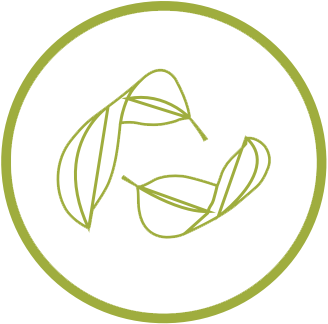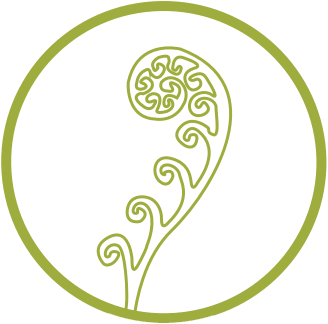In your research for [Biomimicry: Innovation Inspired by Nature], you found that biomimicry is already a burgeoning scientific field. Who are some of the pioneers in biomimicry and what are they doing?
Wes Jackson (The Land Institute) is studying prairies as a model for an agriculture that features edible, perennial polycultures and that would sustain, rather than strain, the land.
Thomas and Ana Moore and Devins Gust ( University of Arizona) are studying how a leaf captures energy, in hopes of making a molecular-sized solar cell. Their light-sensitive “pentad” mimics a photosynthetic reaction center, creating a tiny, sun-powered battery.
Jeffrey Brinker (Sandia National Lab) has mimicked the abalone’s self-assembly process to create an ultra-tough optically clear glass in a low-temperature, silent manufacturing process.
J. Herbert Waite (University of California Santa Barbara) is studying the blue mussel, which attaches itself to rocks via an adhesive that can do what ours can’t-cure and stick underwater. Various teams are attempting to mimic this underwater glue.
Peter Steinberg (Biosignal) has created an anti-bacterial compound that mimics the sea purse. These red algae keeps bacteria from landing on surfaces by jamming their communication signals with an environmentally friendly compound called furanone.
Bruce Roser (Cambridge Biostability) has developed a heat-stable vaccine storage that eliminates the need for costly refrigeration. The process is based on a natural process that enables the resurrection plant to remain in a desiccated state for years.
David Knight and Fritz Vollrath (Oxford University, Spinox) are mimicking the spider’s sustainable manufacturing process to find a way for humans to manufacture fibers without heat or toxins.
Daniel Morse (UC Santa Barbara) has learned to mimic the silica-production process employed by diatoms. This could signal a low-energy, low-toxin route to computer components.
Joanna Aizenberg (Lucent) has mimicked the process by which the brittlestar self-assembles distortion-free lenses out of seawater.
Jay Harman (PAXscientific) has created a super-efficient fan blades, aerators, and propellers based on the geometry of the flow-friendly spiral found in seashells, kelp, and rams horns.
A. K. Geim ( University of Manchester) has developed a glue-free, yet sticky, tape modeled on the dry physical adhesion of the gecko’s “setae” —tiny bristles on their feet that adhere to surfaces through Van Der Waals forces. The sustainability potential here is in “design for disassembly.” Assembling products using gecko tape instead of glue would allow recyclers to disassemble products without adhesive contamination.
Richard Wrangham (Harvard) is zeroing in on medicinal compounds useful to humans by watching chimps heal themselves with plants from nature’s medicine cabinet.
Thomas Eisner (Cornell) is letting the behavior of insects tell him which plants may be good bets for new drugs. If insects ignore a leaf, he figures the plant is full of secondary compounds-defenses for the plant and drugs for us.
Jeremy Mabbitt (Codefarm) and numerous other companies are mimicking natural selection as an optimizing tool in computer software called genetic algorithms.
Various researchers in Industrial Ecology are looking for ways to apply nature’s lessons of economy, efficiency, cooperation, and rootedness to the marketplace. Closed-loop eco-parks, patterned after mature ecosystems like redwood forests, are now being built in Chattanooga, Brownsville, Baltimore, and Cape Charles.
How does biomimicry differ from other bio-approaches?
Biomimicry introduces an era based not on what we can extract from organisms and their ecosystems, but on what we can learn from them. This approach differs greatly from bioutilization, which entails harvesting a product or producer, e.g. cutting wood for floors, wildcrafting medicinal plants. It is also distinctly different than bio-assisted technologies, which involve domesticating an organism to accomplish a function, e.g., bacterial purification of water, cows bred to produce milk. Instead of harvesting or domesticating, biomimics consult organisms; they are inspired by an idea, be it a physical blueprint, a process step in a chemical reaction, or an ecosystem principle such as nutrient cycling. Borrowing an idea is like copying a picture-the original image can remain to inspire others.
The Practice of Biomimicry
The practice of biomimetic invention can proceed from biology to design or from design to biology.
In the biology-to-design approach, a biological phenomenon suggests a new way to solve a human design challenge. Wilhelm Barthlott of the Nees-Institute, University of Bonn studied how leaves such as the lotus manage to remain free of contaminants without the use of detergents. His papers described how a landscape of small bumps and waxy crystals cause water to ball up. Dirt particles teeter on the nano-mountains and are easily picked up by the water, like a snowball lifting leaves from a lawn. He and colleagues worked out how to replicate the geometric profiles of the lotus into commercial products such as a building façade paint that exhibits a nanorough surface when it dries. Rainwater cleans the building. Today, dozens of self-cleaning products such as glass, roofing tiles, and textiles bear the Lotus-effect symbol.
In the design-to-biology approach, the innovator starts with a human design challenge, identifies the core function, and then reviews how various organisms or ecosystems are achieving that function. An example is the quest for a new way to reduce microbial growth without causing antibiotic resistance. Peter Steinberg of the University of New South Wales used a characteristic biomimicry approach. He identified an environment that was teeming with microbes, and then searched for organisms within that environment that had no biofilm on their surfaces. He found his “champion adapter” in the murky waters of Botany Bay Australia. Pseudomonas aeruginosa, a red kelp called sea purse, remains free of microbes by releasing furanones, molecules which interfere with the bacteria’s communication signaling mechanisms. When bacteria are “jammed” by furanone, they are unable to receive a quorum of signals from other bacteria, and without positive “quorum sensing” they don’t begin biofilm formation. Steinberg’s company, Biosignal, Ltd of Eveleigh, Australia, has mimicked these repellant compounds and licenses them to companies producing non-toxic antifouling paints, contact lenses, and surface treatments for hospitals.
When you talk about how we can apply biomimicry to product design, you point to the difference between shallow and deep biomimicry. What do you mean?
The first level of biomimicry is the mimicking of natural form. For instance, you may mimic the hooks and barbules in an owl’s feather to create a fabric that opens anywhere along its surface. Or you can imitate the frayed edges that grant the owl its silent flight. Copying feather design is just the beginning, because it may or may not yield something sustainable.
Deeper biomimicry adds a second level, which is the mimicking of natural process, or how it is made. The owl feather self-assembles at body temperature without toxins or high pressures, by way of nature’s chemistry. The unfurling field of green chemistry attempts to mimic these benign recipes.
At the third level is the mimicking of natural ecosystems. The owl feather is gracefully nested—it’s part of an owl that is part of a forest that is part of a biome that is part of a sustaining biosphere. In the same way, our owl-inspired fabric must be part of a larger economy that works to restore rather than deplete the earth and its people. If you make a bioinspired fabric using green chemistry, but you have workers weaving it in a sweatshop, loading it onto pollution-spewing trucks, and shipping it long distances, you’ve missed the point.
To mimic a natural system, you must ask how each product fits in-is it necessary, is it beautiful, is it part of a nourishing food web of industries, and can it be transported, sold, and reabsorbed in ways that foster a forest-like economy?
If we can biomimic at all three levels-natural form, natural process, and natural system-we’ll begin to do what all well-adapted organisms have learned to do, which is to create conditions conducive to life. Creating conditions conducive to life is not optional; it’s a rite of passage for any organism that manages to fit in here over the long haul. If we want to keep coming home to this place, we’ll need to learn from our predecessors how to filter air, clean water, build soil-how to keep the habitat lush and livable. It’s what good neighbors do.
One of the more radical ideas put forth in your book pertains to a new form of agriculture that models itself on plant communities that are indigenous to the ecosystem. How realistic is this? And is this really new?
Natural systems agriculture looks at a landscape and says “What grows here naturally?” In the Midwest, it’s the prairie. For 5000 years, the prairie has done a great job of holding the soil, resisting pests and weeds, and sponsoring its own fertility, all without our help. The secret of the prairie is that it is composed of perennial plants growing in polycultures (many species in the same field).
Unfortunately, we can’t eat a prairie. Over the last 100 years, we have plowed up the prairie and replaced it with our own agriculture, based on annual plants grown in monocultures (one species for miles). Unlike the prairie’s perennial polycultures, these annual monocultures do need our help.
Using annuals means we have to plow each year, which leads to soil erosion. To make up for poorer soil, we pour on tons of chemical fertilizers. To protect our all-you-can-eat monocultures from pests, we heap on oil-based pesticides. It works out to about 10 kilocalories of petroleum to produce one kilocalorie of food.
The way to get off this “treadmill of vigilance”, says Wes Jackson of the Land Institute, is to breed perennial crops that we can eat and grow them in a prairie-like polyculture. Jackson’s edible prairie would not merely be new; it would be the polar opposite of what we have now. The plants would overwinter, so we wouldn’t need to plow and plant every year, or worry about soil erosion. We wouldn’t need to add synthetic fertilizers because nitrogen-fixing plants would be in the mix. We wouldn’t need to spray biocides because the presence of lots of different plant species would slow down pest outbreaks.
What we would have, instead of an extractive agriculture that mimics industry, is a self-renewing agriculture that mimics nature. Though radical, this idea of breeding a prairie you can eat is quite realistic, when you consider that most of our crops were bred from perennial wild relatives. Over ten thousand years, we turned them into annuals and narrowed their genetic pools. So now we are looking to widen those genetic pools and breed perennial traits back into edible grains.
Right now, natural systems agriculture is at the Kitty Hawk stage-the researchers have proven the agricultural equivalent of drag and lift. Working alone, they will need 25-50 years of wind tunnel tests before domestic prairies can be planted in the Breadbasket. If they get support, the shift could come a lot sooner. It depends on what kind of research we as a society choose to fund. As Chuck Hassebrook of the Rural Affairs Center points out, research is a form of social planning.
What will prevent humans from, as you say, “stealing nature’s thunder and using it in the ongoing campaign against life?”
That’s a good question, because any technology, even if it’s a technology inspired by nature, can be used for good or bad. The airplane, for instance, was inspired by bird flight; a mere eleven years after we invented it, we were bombing people with it. As author Bill McKibben says, our tools are always employed in the service of an ideology. Our ideology-the story we tell ourselves about who we are in the universe- has to change if we are to treat the living Earth with respect.
Right now we tell ourselves that the Earth was put here for our use. That we are at the top of the pyramid when it comes to Earthlings. But of course this is a myth. We’ve had a run of spectacular luck, but we are not necessarily the best survivors over the long haul. We are not immune to the laws of natural selection, and if we overshoot the carrying capacity of the Earth, we will pay the consequences.
Practicing ethical biomimicry will require a change of heart. We will have to climb down from our pedestal and begin to see ourselves as simply a species among species, as one vote in a parliament of 30 million. When we accept this fact, we start to realize that what is good for the living Earth is good for us as well.
If we agree to follow this ethical path, the question becomes: how do we judge the “rightness” of our innovations? How do we make sure that they are life-promoting? Here, too, I think biomimicry can help. The best way to scrutinize our innovations is to compare them to what has come before. Does this strategy or design have precedence in nature? Has something like it been time-tested long enough to wear a seal of approval?
If we use what nature has done as a filter, we stop ourselves from, for instance, transferring genes from one class of organism to another. We wouldn’t put flounder genes into a strawberry plant, for instance. Biomimicry says: if it can’t be found in nature, there is probably a good reason for its absence. It may have been tried, and long ago edited out of the population. Natural selection is wisdom in action.
In the business chapter, you talk about the need to “shift our niche.” What do you mean by that?
A “niche” is a profession in the ecosystem. Right now, we humans are filling a pioneering niche. We are acting like the weeds in a newly turned farmer’s field. These weeds move into a sun-filled space and use nutrients and water as quickly as they can, turning them into plant bodies and plenty of seeds. They are annuals; they don’t bother to put down winter roots or recycle because their moment in the sun is short. Within a few years, they’ll be shaded out by the more efficient, long-lasting perennial bushes and shrubs. That’s why they produce so many seeds; they’re always on to the next sun-drenched horn of plenty.
Back before our world was full, and we always had somewhere else to go, this colonizing “Type I” strategy allowed us to stay one step ahead of reality. These days, when we’ve gone everywhere there is to go, we have to forget about colonizing and learn to close the loops.
Closing the loops means trying to emulate the natural communities that know how to stay put without consuming their ecological capital. Mature ecosystems such as oak-hickory forests are masters of optimizing, rather than maximizing, throughput. They recycle all their wastes, use energy and materials efficiently, and diversify and cooperate to use the habitat without bankrupting it. Ecologists call these Type III communities.
Industrial ecologists are trying to glean lessons from natural communities to actually shift our economy from Type I to Type III. From ragweeds to redwood forests.
The latest business consultants in this field are people fresh from gorilla counts and butterfly surveys. I never thought I’d see the day, but it’s true: the Birkenstocks are teaching the suits.
How would a Biomimetic Revolution come about?
In the book I talk about one possible path to biomimicry, which is modeled after my own experience in trying to renew an aging pond. The steps are simple but profound in their implications: They are 1. Quieting human cleverness, 2. Listening to nature, 3. Echoing nature, and 4. Protecting the wellspring of good ideas through stewardship.
Quieting human cleverness involves the maturing of the human race, the acknowledgment that nature knows best. I think we are coming closer to this. We are seeing that our cleverness has painted us into some corners, and we are open for suggestions.
Listening to nature is the discovery step. It’s important that we interview the flora and fauna of the planet in an organized way. Out of the estimated 5 to 30 million living species on Earth, only about 1.4 million have been named! I would love to see us create a Biological Peace Corps where people can volunteer to inventory biodiversity for two years. I’d also love to see systematics, which is the in-depth study of animal and plant groups, become a sought-after career again. We need people who know all there is to know about particular branches of nature’s tree.
This step of closely listening to nature is not just for scientists, however. We all need to become ecologically literate, and the best way to do that is to immerse ourselves in nature, in childhood and as adults.
Echoing nature is where we actually try to mimic what we discover. Echoing nature will take a cross-fertilization of ideas. The technologists who invent products and systems need to interact with biologists so they can match human needs with nature’s solutions. Task forces and formal societies would allow for periodic interactions, but for more permanent collaborations, we should design university courses that teach biomimetic design.
I can also see using the Internet as a place to store our information. A giant database of biological knowledge would serve as an innovation matchmaking service. An engineer charged with designing a new desalination device, for instance, could easily review the strategies and root-membrane blueprints of the mangrove-a tree that filters seawater with its solar-powered roots. This “Google for Nature’s Solutions” would organize biological research by functional search term (in the vocabulary of designers and engineers). It would place life’s wellspring of evolved ideas where they belong—in the public domain—so the ideas themselves cannot be patented. This is a gigantic, but important, first step to move ideas from biology to human systems design.
Stewardship of wild and settled places should be the natural outgrowth of a biomimetic worldview. Once we see nature as a source of inspiration, a mentor, our relationship with the living world changes. We realize that the only way to keep learning from nature is to safeguard naturalness, which is the source of those good ideas.
How would a Biomimetic Revolution change our lives?
“Doing it nature’s way” has the potential to change the way we grow food, make materials, harness energy, heal ourselves, store information, and conduct business. In each case, nature would be model, measure, and mentor.
Nature as model. In each case, nature would provide the models: solar cells copied from leaves, steely fibers woven spider-style, shatterproof ceramics drawn from mother-of-pearl, cancer cures compliments of chimpanzees, perennial grains inspired by tallgrass, computers that signal like cells, and a closed-loop economy that takes its lessons from redwoods, coral reefs, and oak-hickory forests.
Nature as measure. Beside providing the model, nature would also provide the measure-we would look to nature as a standard against which to judge the “rightness” of our innovations. Are they life promoting? Do they fit in? Will they last?
Nature as Mentor. When we view nature as a source of ideas instead of goods, the rationale for protecting wild species and their habitats becomes self-evident. To have more people realize this is my fondest hope.
In the end, I think biomimicry’s greatest legacy will be more than a stronger fiber or a new drug. It will be gratitude, and from this, an ardent desire to protect the genius that surrounds us.
You emphasize in your talks that we ARE nature, but that we’re a very young species, still trying to find our way.
As a biologist, I see us as a species among species, and that means everything we make and do is natural. When we make a product or build a building, it’s akin to a robin making a nest—it’s an extension of our bodies, and just as subject to natural selection. The real question is not “Is this product or behavior natural?” but rather, “Is it well-adapted to life on earth over the long haul?”
Anything that we design-a product, a process, or a policy–has to ultimately pass muster in the biological realm. It has to help us thrive, but it also has to keep the habitat in tact for our successors. A robin building a nest and an architect building a building should have the same concern: “How will the chicks fare here?”
Biomimicry seems to make so much sense. Why didn’t we think of it years ago?
Well, actually, biomimicry as an approach to innovation is not new. Indigenous peoples relied heavily on the lessons and examples of the organisms around them. Alaskan hunters still stalk seals in exactly the same way that polar bears do, for instance. Many early Western inventions, such as the airplane and the telephone, also took their inspiration directly from nature.
What I do see is biomimicry cropping up again after a long hiatus of hubris brought on in part by the “better living through chemistry” era.
As we learned to synthesize what we needed from petrochemicals, we began to believe we didn’t need nature, and that our ways were superior. Now, with the advent of genetic engineering, some of us have come to fancy ourselves as gods, riding a juggernaut of technology that will grant us independence from the natural world.
The rest of us, of course, are finding it hard to ignore the emergency sirens wailing all around us. Here at the beginning of the twenty first century, environmental reality is setting in, pushing us to find saner and more sustainable ways to live on Earth. Equally important is what is pulling us towards biomimicry-that is, our deepening knowledge of how the natural world works.
Biological knowledge is doubling every five years, growing like a pointillist painting toward a recognizable whole. For the first time in history, we have the instruments-the scopes and satellites-to feel the shiver of a neuron in thought or watch in color as a star is born. When we combine this intensified gaze with the sheer amount of scientific knowledge coming into focus, we suddenly have the capacity to mimic nature like never before.
Your book expresses a sense of urgency. Why is it crucial to explore biomimicry now?
We humans are at a turning point in our evolution. Though we began as a small population in a very large world, we have expanded in number and territory until we are now bursting the seams of that world. There are too many of us, and our habits are unsustainable.
Having reached the limits of nature’s tolerance, we are finally shopping for answers to the question: “How can we live on this home planet without destroying it?”
Just as we are beginning to recognize all there is to learn from the natural world, our models are starting to blink out-not just a few scattered organisms, but entire ecosystems. A new survey by the National Biological Service found that one-half of all native ecosystems in the United States are degraded to the point of endangerment. That makes biomimicry more than just a new way of viewing and valuing nature. It’s also a race to the rescue.
